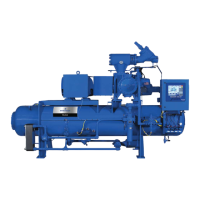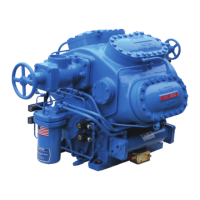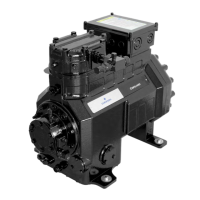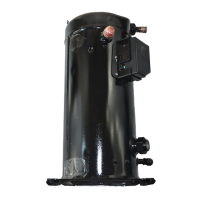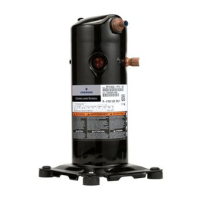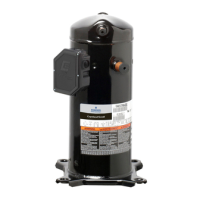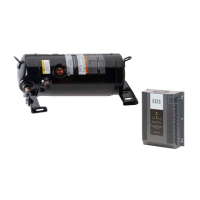3 – 18
Section 3 • Installation
VSS/VSM/VSH/VSSH • Installation, Operation and Maintenance Manual • Emerson • 35391SD
Testing Refrigeration System For Leaks
CAUTION
Do not hydro test compressor unit. Failure to comply
may result in damage to equipment.
CAUTION
The compressor unit along with other system units
contain many components with various pressure
ratings. Pressure relief protection provided considers
the design pressure of a system components.
Before replacing a pressure relief valve with a relief
valve having a higher pressure setting, all system
components must be evaluated for acceptability.
Vilter equipment is tested for leaks at the factory. One
the most important steps in putting a refrigeration sys-
tem into operation is eld testing for leaks. This must be
done to assure a tight system that will operate without
any appreciable loss of refrigerant. To test for leaks, the
system pressure must be built up. Test pressures for vari-
ous refrigerants are listed in ANSI B9.1-1971 code bro-
chure entitle “Safety Code for Mechanical Refrigeration”.
These pressures will usually sufce, however, it is advis-
able to check local codes as they may differ. Before test-
ing may proceed, several things must be done.
First, if test pressures exceed the settings of the system,
relief valves or safety devices, they must be removed
and the connection plugged during the test. Secondly,
all valves should be opened except those leading to the
atmosphere. Then, open all solenoids and pressure reg-
ulators by the manual lifting stems. All bypass arrange-
ments must also be opened. Because of differences in
characteristics of the various refrigerants, two different
testing methods are necessary.
Ammonia Systems
Dry nitrogen may be used to raise the pressure in an am-
monia system to the proper level for the test. The gas
may be put into the system through the charging valve
or any other suitable opening. Adjust the pressure regu-
lator on the bottle to prevent over-pressurization. Do
not exceed the pressure rating on the vessel with the
lowest pressure rating.
Carbon Dioxide should NOT be used as a testing gas in a
system where ammonia is already dissolved in any mois-
ture remaining. This will cause ammonium carbonate to
precipitate when the CO
2
is added. If heavy enough, this
precipitate may cause the machine to freeze and clog
the strainer.
A mixture of four parts water to one part liquid soap,
with a few drops of glycerin added, makes a good solu-
tion. Apply this mixture with a one inch round brush at
all anges, threaded joints, and welds. Repair all visible
leaks. If possible, leave the pressure on over night. A
small pressure drop of 5 lbs. Over this period indicates a
very tight system.
Remember to note the ambient temperature, as a
change in temperature will cause a change in pressure.
After the system is thoroughly tested, open all valves on
the lowest part of the system so the gas will oat away
from the compressor. This prevents any dirt or foreign
particles from entering the compressor and contaminat-
ing the working parts. The oil should then be charged
into the compressor.
Charge a small amount of ammonia into the system and
pressurize the system to its respective design pressure.
Pass a lit sulfur stick around all joints and connections.
Any leaks will be indicated by a heavy cloud of smoke.
If any leaks are observed during this test, they must be
repaired and rechecked before the system can be con-
sidered tight and ready for evacuation.
Halocarbon Refrigerant Systems
“Oil pumped” dry nitrogen, or anhydrous CO
2
in this or-
der of preference may be used to raise the pressure to
the proper level for testing.
When the proper pressure is attained, test for leaks with
the soap mixture previously described. After all leaks are
found and marked, relieve the system pressure and re-
pair the leaks. Never attempt to repair soldered or weld-
ed joints while the system is under pressure. Soldered
joints should be opened and re soldered.
Do not simply add more solder to the leaking joint. After
all the joints have been repaired and the system is consid-
ered “tight” the system may be tested with refrigerant.
Attach a drum of the refrigerant to be used in the sys-
tem and allow the gas to enter until a pressure of 5 psig
is reached.
Remove the refrigerant drum and bring the pressure
to the recommended test level with oil pumped dry ni-
trogen or CO
2
. Then check the entire system again for
leaks, using a halide torch or electronic leak detector.
Be sure to check all anged, welded, screwed and sol-
dered joints, all gasketed joints, and all parting lines on
castings. If any leaks are found, they must be repaired
and rechecked before the system can be considered
tight again, remembering that no repair should be made
to welded or soldered joins while the system is under
pressure.
